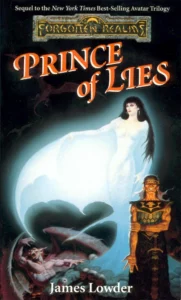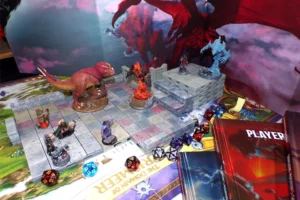America’s most popular tabletop role playing game turns 50 this year.
Dungeons & Dragons, known for its epic fantasy settings and fateful roles of the dice, was co-created by Gary Gygax and Dave Arneson and originally published from Gygax’s home in Lake Geneva, Wisconsin. Over the years, the game has evolved from the traditional domain of “nerds” to a mainstream cultural phenomenon, most recently driving the plot of Netflix’s popular series “Stranger Things” and inspiring the 2023 film “Dungeons & Dragons: Honor Among Thieves” starring Chris Pine and Hugh Grant.
Many people have had a hand in the game’s success, including UW-Milwaukee alumni. James Lowder, who graduated with his Master’s degree in English in 1999, and Scott Bruner, who earned his PhD in English in 2023, are experts on D&D – Bruner because he studies tabletop and role playing games, and Lowder because he worked for Tactical Studies Rules (TSR), the original publisher of Dungeons & Dragons, and Wizards of the Coast, its current publisher. He has written and edited game content for D&D, as well as related novels and comics.
Why has Dungeons & Dragons not only survived for 50 years, but become such an intrinsic part of American culture that the U.S. Postal Service has issued a set of commemorative D&D stamps to mark the anniversary?
Bruner has a theory: “It’s a socially acceptable practice that says, hey, it’s okay to find four of your friends and get really geeky around the table and play make believe like you did as kids.”
Origin stories
When Dungeons & Dragons first appeared on the scene, James Lowder was fascinated.
“I was among the first wave of players for Dungeons & Dragons in the 1970s. I got started because I had friends with an older sibling who played,” Lowder recalled. “I immediately realized that this was the game and the art form for me. In essence, role-playing games like Dungeons & Dragons are group storytelling with the rule set structuring and gamifying the tales you tell.”

Players create a character from certain classes – a barbarian, a rogue, a wizard, a bard, etc. Each class features different attributes and skills that a character might have. Characters can gain new skills or strengthen existing ones as they gain more experience. Gameplay is facilitated through a Dungeon Master, a person who presents the storyline to the players, who decide their characters’ actions based on the resources they have, the members in their party, and the plot of the game. Whether the characters’ actions are successful is determined by the roll of the dice. Potential story settings and other rules are laid out in extensive handbooks.
Lowder is very familiar with all incarnations of the game. For D&D specifically, he helped write and edit most often for the first three editions. He has also consulted on projects for the latest version.
“I’m back doing things connected to D&D because the publisher has been revisiting storylines and characters I created in my novels, such as the hero Artus Cimber and the monstrous dragon turtle Aramag, and using those as central elements in new RPG and multimedia projects,” he said.

Yes, D&D gameplay draws from D&D novels, and Lowder was in on the ground floor. When he was first hired at TSR as an editorial assistant in the book department in the late 1980s, the company was on the verge of breaking out as a major fantasy/science fiction publisher. Thanks to his knowledge of the game and his fiction editing skills, Lowder was fast-tracked into a series editor role, working on such major lines as Ravenloft and the Forgotten Realms, which was the setting for the recent Hollywood film. He also did freelance work for the game department, editing and designing role-playing game material, and eventually became a specialist for transmedia projects.
But Lowder had always wanted to be a fiction writer, ever since he was a child. He broke in as a novelist at TSR, penning several D&D-related books, including Crusade (1991), Prince of Lies (1993), and Spectre of the Black Rose (1999), though the creations nearest his heart are the characters from his lost world fantasy The Ring of Winter (1993).
These days, Lowder works as a freelance writer, editor, and publishing consultant for fiction, RPGs, and comics, as well as an advocate and mentor for artists, writers, and designers. His annual holiday “Games to Gift” segment highlighting new tabletop releases has run on Milwaukee’s public radio station since 2010.
D&D goes mainstream
Dungeons & Dragons has not only permeated popular culture in books, television, and movies, but it’s become such an intrinsic part of life that people who have never played the game are nevertheless influenced by it.
“For instance, the concept of ‘leveling up’ your credit card comes from Dungeons & Dragons,” Bruner said. “There are concepts we have ‘gamified,’ and most of the elements of gamification come from Dungeons & Dragons. … D&D has infiltrated the way we think about advancement, the concept of experience points.”

Bruner discusses that and more on the podcast that he co-hosts with D&D historian Ben Riggs, called “Reading D&D Aloud.” The two read and discuss the game’s founding rulebooks and invite guests to talk about D&D culture and history. Bruner also runs a D&D game for several UWM professors and colleagues. In fact, he added, UWM has a Dungeons & Dragons club and a gaming club. Serious Play at UWM is a collaboration between students and faculty who study games and gaming, including D&D.
Even as it has become more corporate over the decades, D&D, along with the role playing game market that came after it, has become more welcoming and accessible, Bruner mused. The barrier to entry has never been lower and the game has become much more diverse. Recent D&D releases have foregrounded diversity both within the imaginary worlds and in their table of contents. The award-winning “Journeys through the Radiant Citadel” (2022) was the first D&D product to feature adventures written entirely by designers of color.
As D&D continues to change, it’s hard to say what its next 50 years will look like.
“Like all mass media, the future of Dungeons & Dragons will be impacted by the choices its corporate owners make about how their audience will interact with the material they publish,” Lowder said. “Will D&D continue to be an open system where one rulebook, purchased one time, can sustain infinite campaigns or will its owners attempt to shift it to a subscription model, with the rules locked away within a highly monetized walled garden?”
One thing is for certain, said Bruner.
“Dungeons & Dragons is timeless. We’re going to be exploring what tabletop roleplaying games mean in the future in new ways, no matter what happens to how they’re published. You can’t publish and you can’t sell make believe.”
By Sarah Vickery, College of Letters & Science
